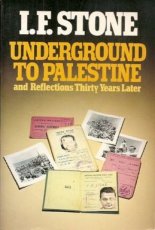Underground to Palestine
Underground to Palestine
Isidor Feinstein Stone (better known as I.F. Stone or Izzy Stone) was an American investigative journalist.
He is best remembered for his self-published newsletter, I.F. Stone's Weekly, which was ranked 16th in a poll of his fellow journalists of "The Top 100 Works of Journalism in the United States in the 20th Century."
Underground to Palestine, first published in 1946, is the first-hand account of journalist I. F. Stone about the hundreds of thousands of European Jews attempting to reach the new Jewish homeland of Palestine following World War Two. With the help of agents of the Haganah, the Jewish military force in Palestine who were arranging this exodus, he traveled with Holocaust survivors from displaced person camps in Germany and Poland on over-crowded trains and on foot, crossing at times unfriendly borders, to southern Europe. From there, Stone joined more than a thousand refugees as they crowded onto an illegal ship, and departed with the aim of defying the British blockade to reach Palestine and a new life as free Jews. Along the way, Stone documented the stories of the concentration camp survivors in this moving story of the human will and the struggle to survive.
In the spring of 1946, I.F. Stone left his usual newspaper assignments behind for a clandestine mission—to report on the illegal exodus of Jews from Europe to Palestine. With the help of agents of the Haganah, the Jewish military force in Palestine who were arranging this exodus, he travelled with Holocaust survivors from displaced person camps in Germany and Poland by rickety train and on foot, across at times unfriendly borders, to Southern Europe. From there, he joined more than a thousand refugees as they crammed into an illegal ship, manned by sailors from Brooklyn and elsewhere, and took off, with the aim of defying the British blockade.
Stone makes clear that this is no ordinary piece of dispassionate journalism—as a Jew, his heart is with the refugees and the Haganah agents who are shepherding them. Still, Stone brings all his powers as a journalist (and his knowledge of Yiddish and French) to convey their story in graphic detail, by offering a first person account that is comparable in clarity and power to Primo Levi’s The Reawakening. In doing so, he fulfills his goals of reporting about what he believed to be a major historical event of his time and advocating for pressure on Britain to change its policy.
For the 1978 paperback reissue edition of Underground to Palestine, Stone appends two essays in which he presents his criticisms of Israeli government policy regarding the conflict with the Palestinians. He says “History over and over again has proven magnanimity a better safeguard than myopic military thinking.” He decries efforts by leaders of the American Jewish community to stifle the kind of robust debate about Israeli policy, which, he points out, occurs all the time within Israel. In addition, he provides an historical overview of how leading figures in the Zionist movement, such as Achad Ha’am. A.D. Gordon, Judah Magnes, Moshe Smilansky, and Martin Buber, advocated fair treatment, generosity, and rapproachment with the Palestinians including, prior to 1948, pressing for the establishment of a bi-national state. Although the situation on the ground today is worse than it was 30 years ago (in some ways, as Stone predicted), Stone would still be urging readers to do what they can to promote what he calls “the Other Zionism, a recognition that two peoples—not one--occupy the same land and have the same rights”.
Paperback

